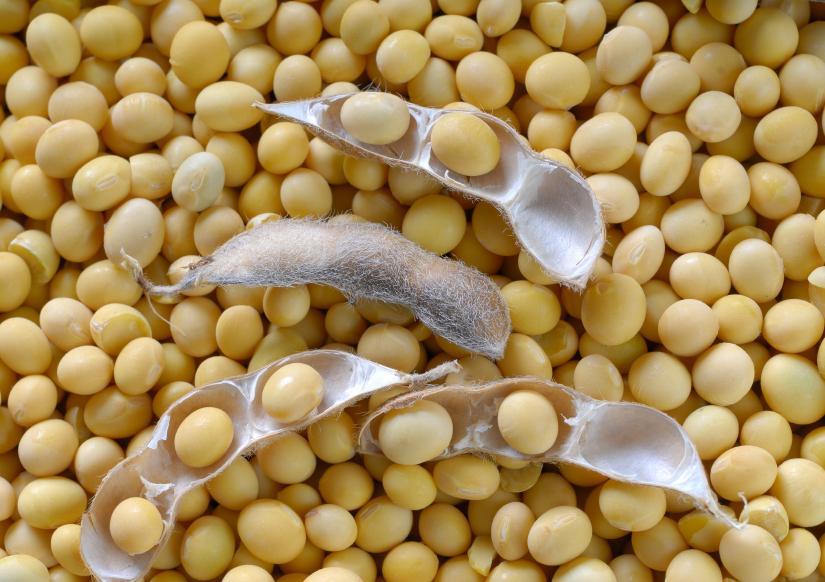
Soybean Cultivation
- Scientific name: Glycine max.
- Family Fabaceae
- Origin: Eastern Asia or China.
Distribution
Soybean growing countries are the USA, China, Brazil, and Argentina. These countries grow about 90 % of the total world soybean. In the Asia Pacific region, soybean is cultivated in China, Pakistan, and India.
Importance
- Soybean contains 38-42 % protein and 17-22 % oil.
- Soya protein is a low-cost and highly nutritious protein.
- It also contains essential amino acids.
- It is a necessary constituent of some of the infant food and milk substitutes.
- Soya milk is essential preparation from the soybean.
- Soybean is rich in polyunsaturated fatty acid and more linoleic acid. This results in rapid oxidation and deterioration of oil quality.
Soybean production technology
Climate
- Soybean grows well in a warm and moist climate.
- 26-33C is optimum for most cultivars.
- The minimum temperature for effective growth is about 100C.
- 50-70 cm rainfall with the warm condition is essential in the early growth stage.
- During maturity, cool and dry condition are desirable.
Soil
- Loam, sandy loam, and clay loam are suitable for soybean cultivation.
- In Kharif season, high land and the field should have efficient drainage during the crop growth period are ideal for cultivation and Rabi season.
- It can be cultivated in medium-high land.
- Soil pH 6.0-7.5 is preferable.
Varieties
- Bragg, Devis, Shohag, Bangladesh soybean 4, BARI soybean 5, 6 etc.
Land Preparation
- If there is less moisture in the field, one free presowing irrigation should be given.
- 4-5 ploughing followed by laddering is enough to make the soil well pulverized for sowing soybean seeds. It requires deep ploughing. The weeds and stubbles should be picked up, collected and thrown out.
Seed Rate
- Shohag, Bragg, Devis: 70-80 kg/ha.
- Bangladesh soybean 4: 40-50 kg/ha.
Seed treatment
- Treating the seed with Vitavax200 to prevent the fungal attack.
Time of sowing
- Rabi crop: Mid December Mid January.
- Kharif crop: Mid-July to Mid-September (Late Kharif sowing may be done upto 30 October).
Method of sowing
- Line sowing is good, but broadcasting can be done.
Spacing
- Rabi crop: Row to Row distance 20-30 cm. and Plant to Plant distance 46 cm.
- Kharif crop: Row to row distance 40 cm. and Plant to plant distance 46 cm.
Soybean planting depth
- In heavy soil: 23 cm.
- In light soil: 34 cm.
Fertilizer Application
- Fertilizer Quantity (Kg/ha): Urea 50-60, TSP 150-175, MoP 100-120, Gypsum 80-115, Boron 8-10.
- All fertilizer is applied in the final land preparation.
- Use biofertilizer @ 65-75 g/ 1 kg of seed while sowing the seed.
- If biofertilizer is used, no need for Urea fertilizing.
Intercultural operation
Weeds in soybean crop: Soybean is susceptible to early weed competition. 1-2 weeding can be done. Weeding should be done at 20-25 days after germination; other weeding 40-55 days after germination.
Thinning: If plant density is high, it needs thinning.
- In Rabi season: 50-60 plant/ Sq. meter.
- In Kharif season: 40-50 plant/ Sq. meter.
Soybean crop irrigation:
- Rabi crop: 2 irrigation one of 20-25 DAS (before flowering) and other 55-60 DAS (Pod formation stage).
- Kharif crop: Drain outstanding water.
Insect pest
- Scorpion beetle, Cutworm, Leaf wrapping beetle, Stem fly beetle are significant pest of soybean.
Control
- Use resistant varieties. e.g. Sohag, BARI soybean 6.
- Destroy the larvae with a wrapper leaf.
- Clean cultivation should be followed.
- Spraying with Sumithion 57 EC/ Sevin 20 EC @ 1 litre of water 2 times at 10 days interval.
Harvesting
- The growth duration is 90-120 days.
- When soybean plants mature, they start dropping their leaves, the leaves turn yellow, and the pod become brown.
- At maturity, pods dry out quickly.
- At harvest, the seed moisture content should be about 15 %.
- The crop may be harvested by hand, breaking the stalks on the ground level or by sickle.
Post-harvest operation
- Threshing and Cleaning: The harvested plants are to be well dried in the sun. After drying, the crop may be threshed by beating pods with a handstick that separates the pod’s seeds. If stalks are long, they may be threshed by a bullock. The plant parts are then removed from the seed mixture, and the seeds are clean by winnowing and sieving.
- Drying and storing: Seeds are to sun-dried at 23 days. The dried seeds are packed in polybags and then stored in closed drums or tins. It is necessary to dry the stored seeds once a month during the summer season to avoid pest attacks.
Yield
- Depending on the variety, the yield ranges from 1.82.1 ton/ha.
